You can freeze greek yogurt, but it comes at a cost – it separates a bit and becomes grainy. Eating it “raw” after defrosting isn’t a terrible experience, but there are better ways to use it.
If you have a few too many cups of greek yogurt or some leftovers you have no plans of using anytime soon, freezing this dairy product is worth considering.
It’s not an ideal solution because greek yogurt isn’t one of the dairy products that freeze well (like, e.g., parmesan cheese). And you can’t just put it in the freezer and eat it like ice cream, either.
But if you’re using it in any cooked dish or maybe a smoothie, you’re in luck because defrosted greek yogurt works perfectly in those.
Want to learn more about the ins and outs of freezing greek yogurt? Read on.

Can You Freeze Greek Yogurt?
You can freeze greek yogurt, but its texture is going to change after defrosting. It’ll lose its smoothness and become a bit chunky. Plus, as a result of separation, it will probably lose a bit of its thickness.
Mine, for instance, was very thick but ended up noticeably thinner after thawing.
The texture change isn’t huge, but it’s hard to miss, and eating defrosted greek yogurt with fresh fruit isn’t nearly as good as eating the same fruits with a fresh cup.
Here’s how a container of defrosted greek yogurt looks like:
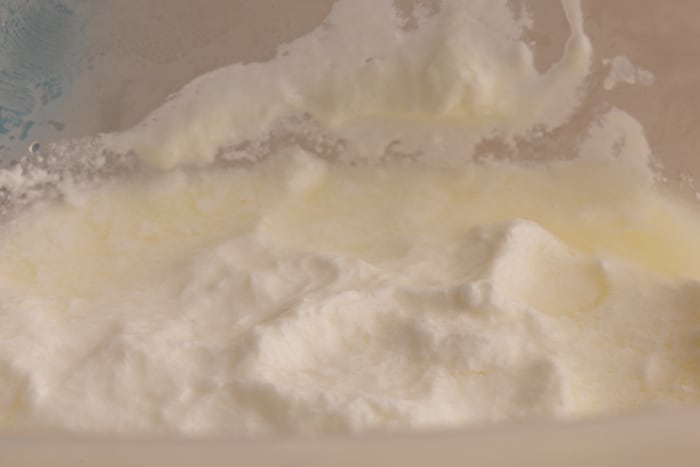
As you can see, there’s quite a lot of liquid separated on top.
Of course, you can grab a spoon and stir that whey in. Here’s how my greek yogurt looks like after mixing:
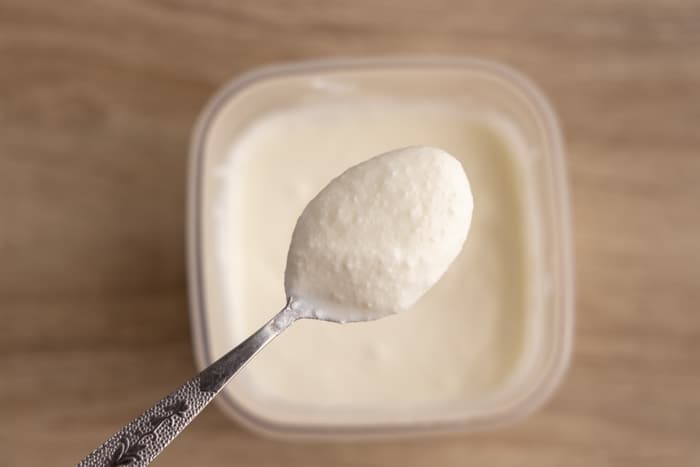
It’s better, but there are small lumps all over the place. That’s what I meant by saying it’s “grainy.”
Now, you can certainly eat it straight from the container or with some fresh fruit (or however else you like it), but those choices aren’t ideal.
Frozen and defrosted greek yogurt works best in cooked and baked dishes, or in recipes where its texture isn’t crucial to the dish itself.
Smoothies are a great example of the latter category. It doesn’t matter that much if the yogurt is smooth or if it’s on the thicker or thinner side. It’s going to make a delicious smoothie anyway.
Freezing for Smoothies
Freezing greek yogurt works well for smoothies. You have two ways to go about this:
- Freeze yogurt in an ice cube tray, and use those cubes instead of ice in your smoothies.
- Freeze and defrost your yogurt the regular way, then pour it into your blender along with the rest of the ingredients and blend it.
The first option requires a bit more hands-on time but allows you to make your smoothies cool without diluting them with water from the ice cubes. Feel free to try it out if you’re using ice in your smoothies.
When it comes to the method itself, I talk more about freezing yogurt in an ice cube tray later in the article.
Eating It Frozen
Unfortunately, you can’t just freeze greek yogurt and eat it frozen like ice cream. Greek yogurt freezes solid and trying to scoop it the way you scoop your favorite ice cream isn’t going to work.
Here’s how frozen greek yogurt looks like:
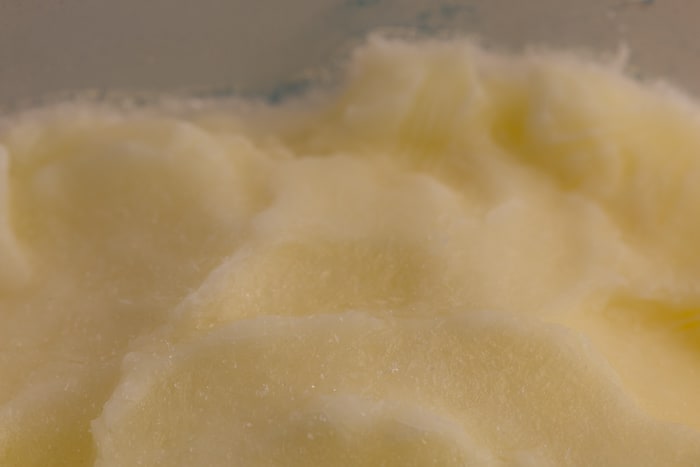
It doesn’t look like ice cream, does it?
To make “real” ice cream, you need an ice cream machine, or at least an ice cream maker attachment to your stand mixer. Sad but true.
That said, there are hundreds of frozen yogurt recipes out there. You can divide them into at least two categories:
- You mix yogurt with frozen fruit, maybe add a sweetener, and eat it immediately. In these, you don’t even freeze the yogurt.
- You blend fruit with yogurt and some cream cheese or heavy cream, then freeze it for 1 to 2 hours so that it gets thicker, ice-cream-like in texture. If you leave it in the freezer for like 4 to 8 hours, it’s going to freeze solid.
As you can tell, both of these types are great if you want to eat the yogurt immediately or soon, and neither works if you need to freeze it long-term.
If you’re ever reading one of those “frozen yogurt” recipes, make sure to check what the author says about freezing that dessert. 99 out of 100 times, they’re going to say you either shouldn’t freeze it at all or only for a limited time to achieve the desired texture.
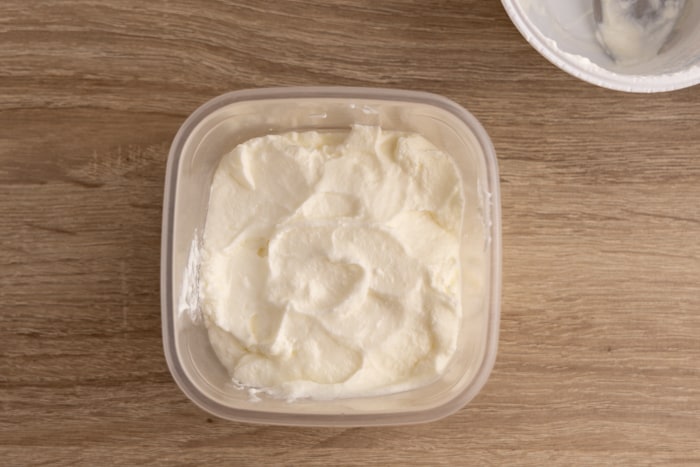
Manufacturers
If you read through manufacturers’ FAQ pages, many of them mention you can freeze their yogurts.
Here’s what Chobani says on freezing their yogurt:
Absolutely! (…) When you open it to enjoy, it’ll have a slightly different texture, whether eaten frozen or thawed, but makes for a refreshing treat.
Chobani
So if you ever wondered if you can freeze Chobani greek yogurt, the answer is affirmative. Even the company itself says you can.
How to Freeze Greek Yogurt
This is my method of freezing greek yogurt. It’s super simple, requires only a couple of airtight containers, and takes a total of like 5 minutes of hands-on time.
After the main method, I cover a couple of modifications, so that you can customize it to your needs.
Here’s what to do:
- Plan on how you’re going to use the yogurt. This is crucial. Without a simple plan in place, it’s difficult to figure out the portions. That means you’re likely to end up with leftovers that need to be dealt with. A bit of planning avoids the issue whatsoever. I give you a handful of ideas for how to use thawed greek yogurt later in the article.
- Portion the yogurt into airtight containers. Spoon into each container as much as you need for every dish you planned. Close each one tightly. Add labels with name and date if you like.
- Freeze all the containers.
And you’re done.
How long does it take for greek yogurt to freeze, you ask? It all depends on the amount and container size.
If you’re freezing half a cup of yogurt in a small square container, it should freeze in like 3 to 4 hours. But if you switch it to a wide rectangular one so that there’s only like half an inch of yogurt in it, it’ll likely be done in 2 hours.
I usually assume the yogurt needs at least 4 hours to freeze or overnight if I’m freezing a larger amount.
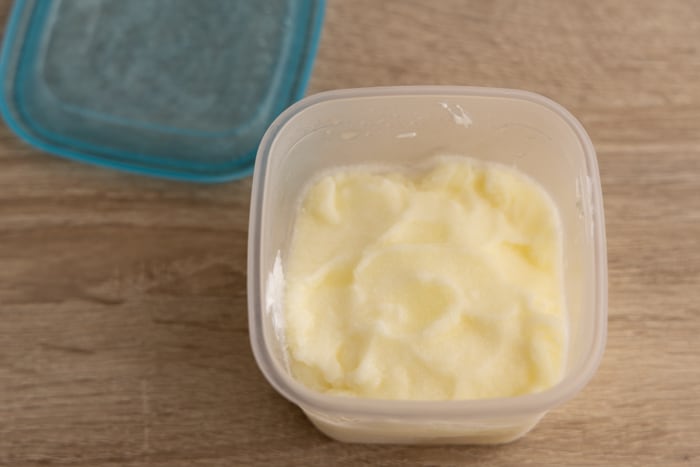
Can You Freeze It in Its Container?
Sure, you can freeze greek yogurt in its container. If the amount in a single cup works perfectly for how you’re going to use it, just put the yogurt in the freezer.
Every yogurt cup has at least a bit of headspace, so chances of the container bursting in the freezer are pretty much none.
Plus, you don’t need to label anything because every possible bit of info is already there.
Freezing in an Ice Cube Tray
Freezing yogurt in an ice cube tray is an excellent option for smoothies, but also if you don’t yet have a plan in place for using the yogurt.
For the latter, you can just pop and defrost how many cubes you need for the recipe you’re cooking and leave the rest in the freezer.
Here’s how to freeze greek yogurt in an ice cube tray:
- Pour yogurt in an ice cube tray.
- Place the tray in the freezer until the cubes are solid. Assume they need at least 2 to 3 hours to freeze. I leave them there overnight.
- Transfer the cubes into an airtight container or freezer bag. By doing this, you get your tray back, and the frozen yogurt takes less room in the freezer. Plus, the cubes are a bit better protected from freezer burn.
- Chuck the bag or container in the freezer.
If the tray is too small, or you want fewer but larger portions, you might use a muffin tin instead. It will be more difficult to remove the frozen yogurt from the tin, but with a fork or a knife, you should make it work.

How Long Can You Freeze Greek Yogurt?
Try to use frozen greek yogurt within three months.
The 3-month mark isn’t special by any means, but the longer your yogurt sits in the freezer, the worse its overall quality will be. And the more likely you’re to leave it there for another half a year or so.
Interestingly, some brands say that you can only store their yogurts in the freezer up to the date on the label. For example, here’s how Chobani puts it:
Frozen Chobani yogurt can be stored in your freezer up to the expiration date listed on the container.
Chobani
To me, that doesn’t make much sense. I might as well leave it in the fridge, and it should be okay. Why bother freezing, then?
In other words, I have no idea what’s the reasoning here, and I ignore that advice whatsoever.
If you tend to forget about using food that you put in the freeze, make a plan to use your frozen yogurt within a month of freezing. And even add it to your calendar if that’s what it takes to get it done.
Defrosting Greek Yogurt
Defrost your greek yogurt overnight in the fridge. Depending on the container size and amount, it needs 2 to 8 hours, hence the recommendation.
To speed things up a bit and make sure it’s nice and thawed in the morning, place the container or bag in a bowl of lukewarm water. Make sure the bag is leakproof, though.
Here’s how the setup looks like:
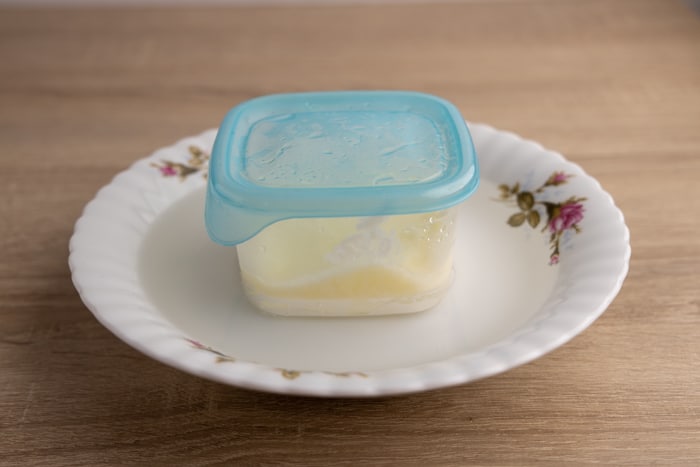
Once it’s defrosted, there’s going to be a bit of liquid on the surface, like I mentioned earlier. You can either remove that liquid with a teaspoon or stir it in.
I usually remove large pockets of water and incorporate the rest. It doesn’t make that much of a difference which option you choose.
Once your yogurt is stirred, it’s ready to use.
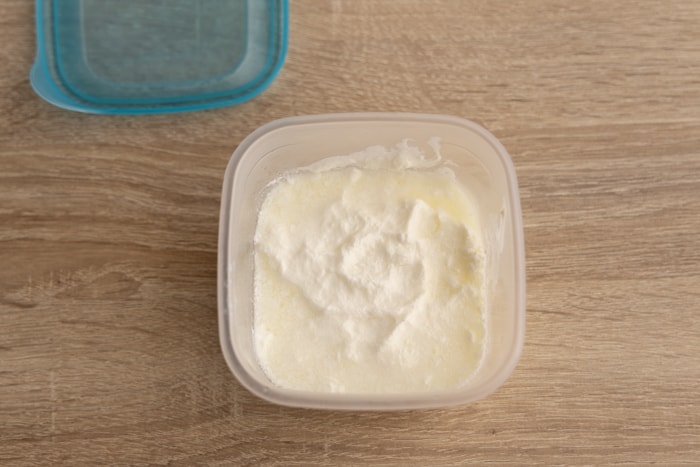
Refreezing
You can refreeze any leftover greek yogurt that you thawed in the fridge. Contrary to popular belief, refreezing food that’s been defrosted in the refrigerator is safe.
Of course, that doesn’t mean that doing so is perfectly fine. It isn’t.
The main issue is that every time you freeze and thaw any food, its quality decreases. And doing that over and over deteriorates the quality even further.
That’s why I recommend portioning greek yogurt before freezing, so that you avoid leftovers that you might need to refreeze.
Using Defrosted Greek Yogurt
As I already mentioned, frozen and defrosted greek yogurt works best in smoothies and any cooked or baked dishes. Those include:
- pancakes, waffles, and the like (my favorite option, as you can tell by the photos in this article)
- cakes and other baked goods
- swirling into soups (especially ones that you blend afterward)
- adding to casseroles and chillis
- smoothies
Defrosted yogurt should work in any dish where it’s cooked, so whatever recipe you already know and like that meets this criterion should work.
One thing worth paying attention to is how yogurt’s texture affects the dish itself.
If your defrosted yogurt is a bit thinner than what’s best for the waffles, you might need to add a bit more flour to fix that. Or a bit less if you removed the separated whey and the yogurt got thicker.
Because of that, it’s by far the best to use thawed greek yogurt in recipes that you’re familiar with. This way, you can adjust things on the fly if need be.

Substitute Defrosted Yogurt for Fresh Yogurt
The easiest way to use greek yogurt that you froze is to substitute it for some of the fresh yogurt in your recipe.
Say you’re making a big smoothie that uses 2 cups of yogurt, and you have half a cup of frozen yogurt. Great. You can defrost that half a cup and use it along with one and a half cups of fresh greek yogurt.

If you froze your greek yogurt willy-nilly without planning how you’re going to use it and portioning it accordingly, this method is your get-out-of-jail-free card.
I used this one for the pancakes I made for this article.